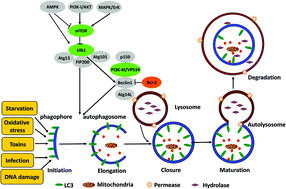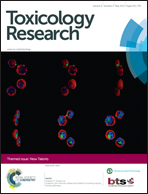Autophagy as the effector and player in DNA damage response of cells to genotoxicants
Abstract
Autophagy is a highly conserved pathway in eukaryotic cells induced by a variety of stimuli to remove superfluous or damaged organelles or abnormally aggregated proteins to maintain cellular homeostasis. A remarkable progress in our understanding of autophagy has been made in the past decade, not only regarding the molecular mechanism, but also its fundamental roles in the biological effects of various environmental stresses or the development of some human diseases. The genome of eukaryotic cells is constantly threatened by endogenous and exogenous genotoxic factors. Research in recent years has demonstrated that autophagy is not only one of the fundamental effects of genotoxicants but also a critical player in DNA damage response to genotoxic stress. A series of DNA damage response (DDR) proteins including ATM, p53, PARP-1, DNA-PKcs, TIP60, and so on have been demonstrated to play important roles in DNA damage induced autophagy, which functions as a protective measure to promote cell survival. Autophagy was also shown to play roles in the cellular responses to DNA damage, e.g. cell cycle regulation, apoptosis. Although the importance of autophagy in DDR has been recognized, there are still a lot of questions to answer. For example, how does the cell transduce the nuclei DDR signal to the cytosol to initiate autophagy; what is the mechanism of DDR related autophagy determining cell survival or cell death pathway; and what is the mechanism associating the autophagy and carcinogenesis potential of chronic low dose exposure of toxicants? In this review, we provide an overview and discuss the molecular mechanism of DNA damage induced autophagy, and their mutual regulation and its role in cell fate determination in response to genotoxic effects of environmental toxicants.

- This article is part of the themed collection: New Talents

 Please wait while we load your content...
Please wait while we load your content...